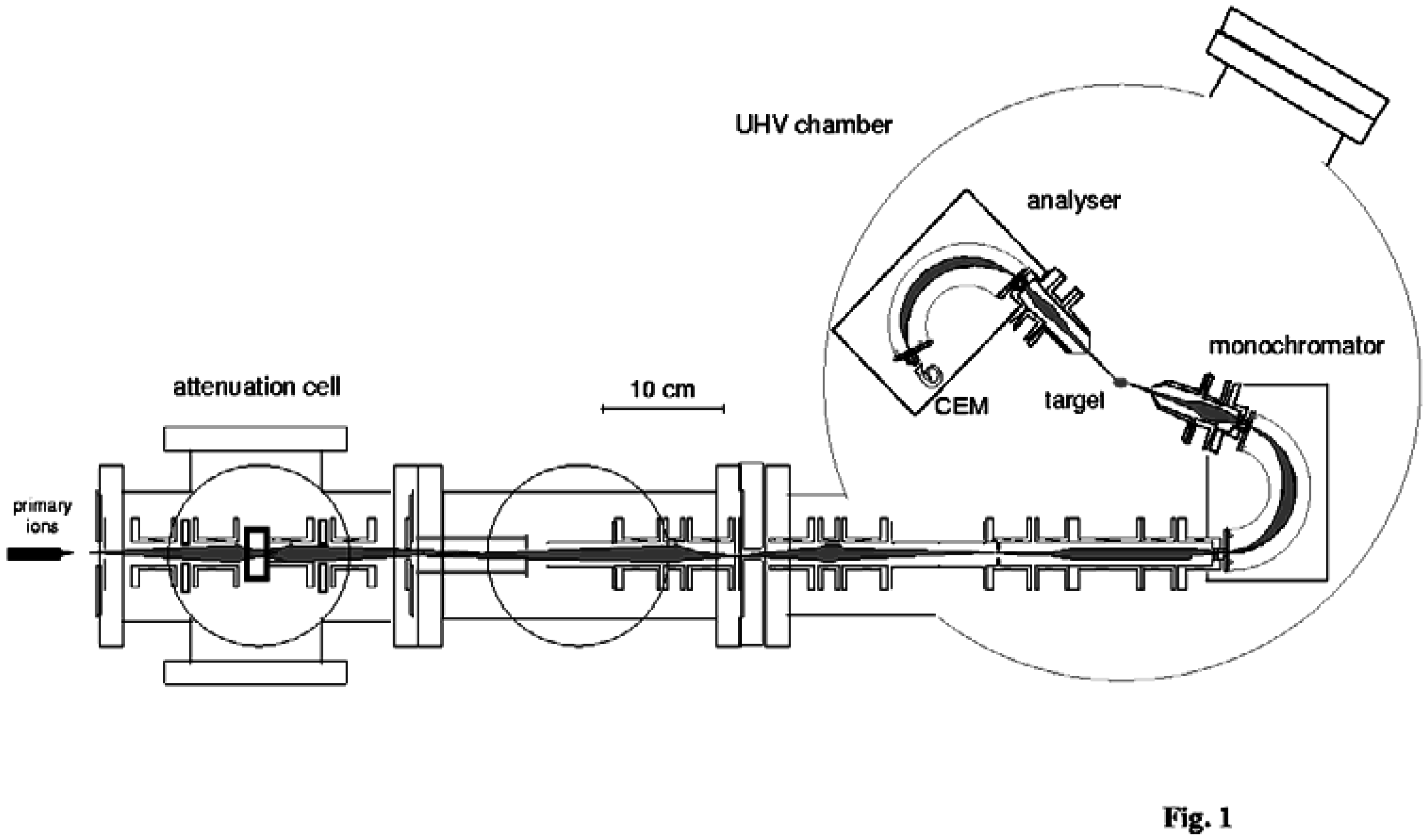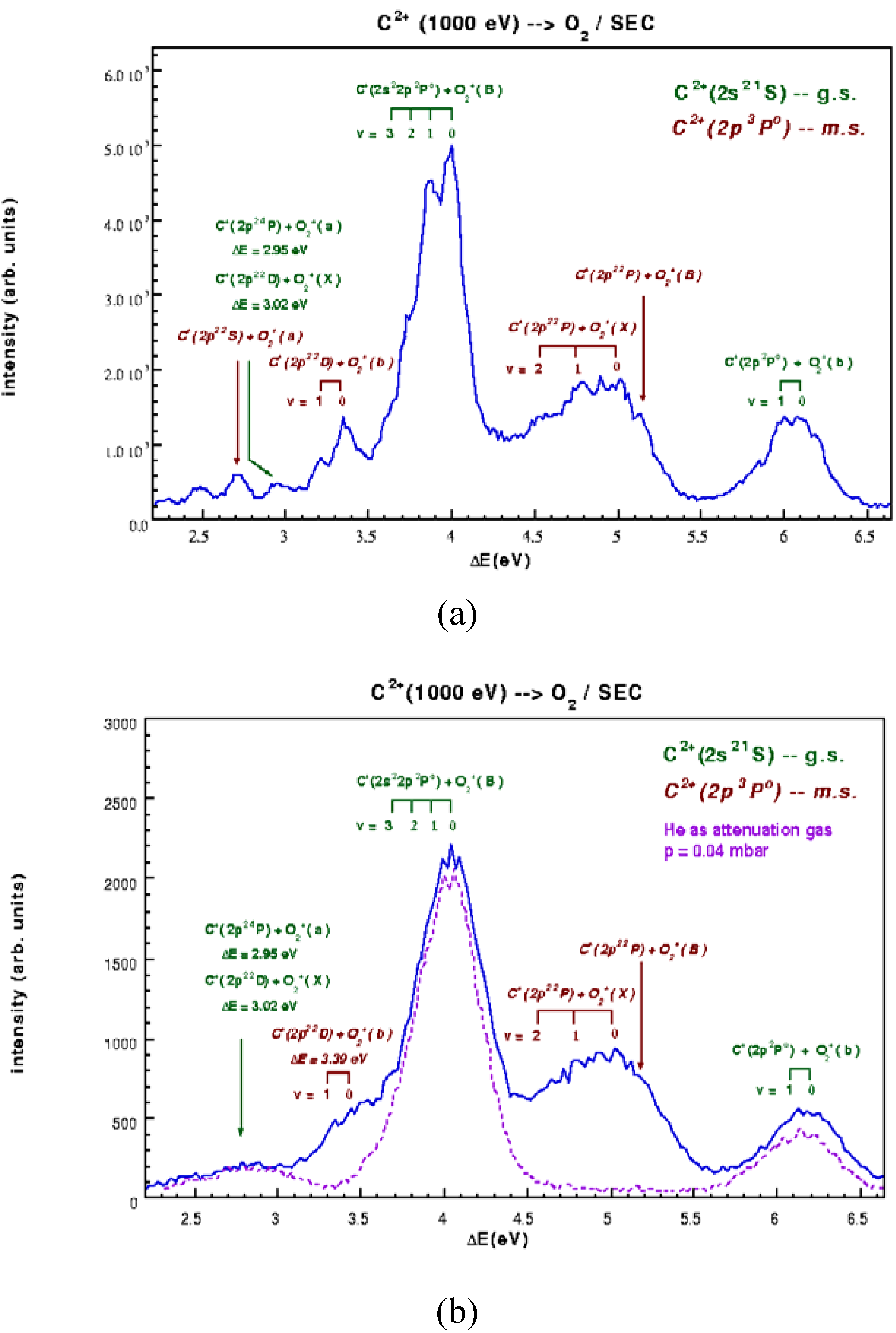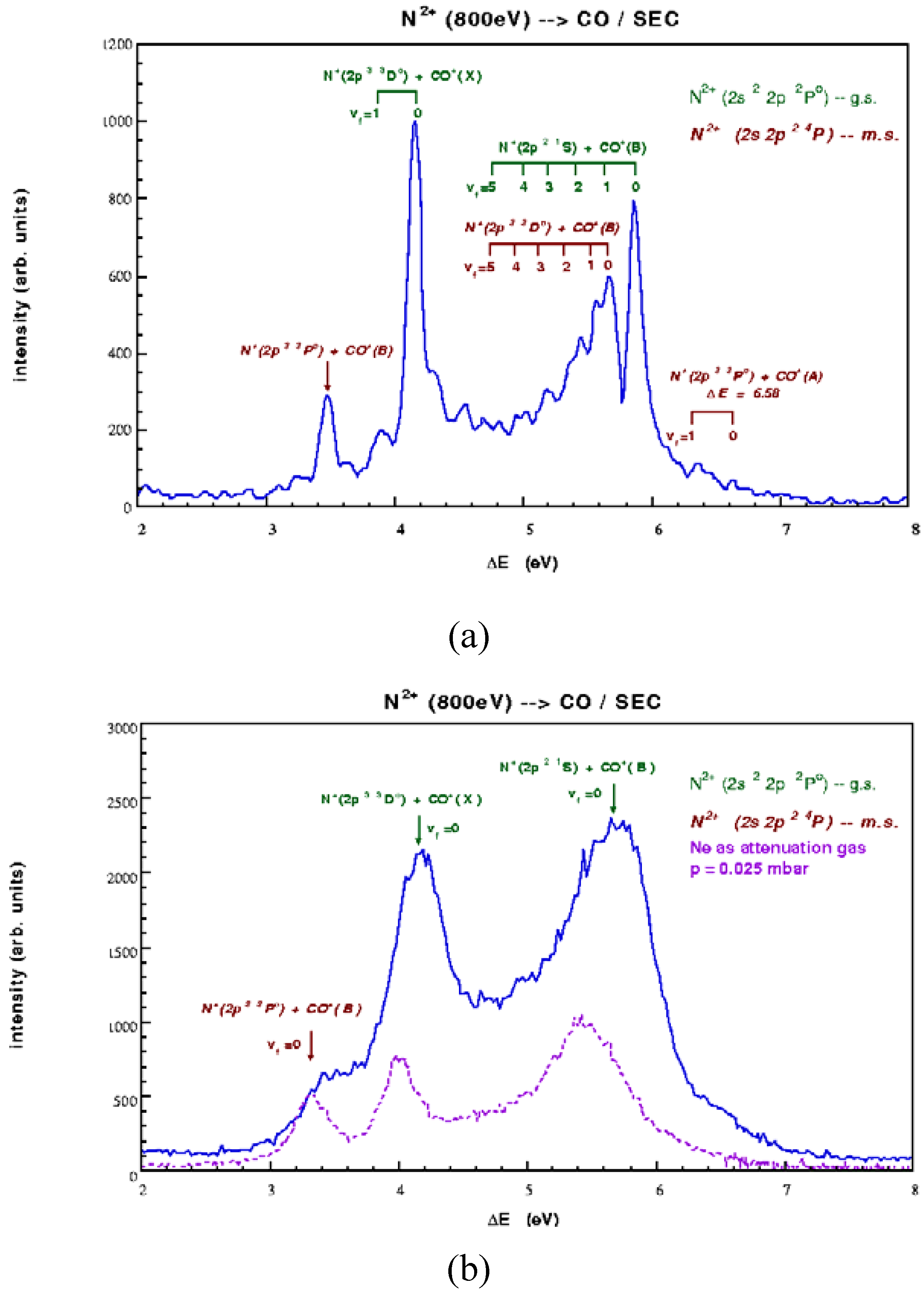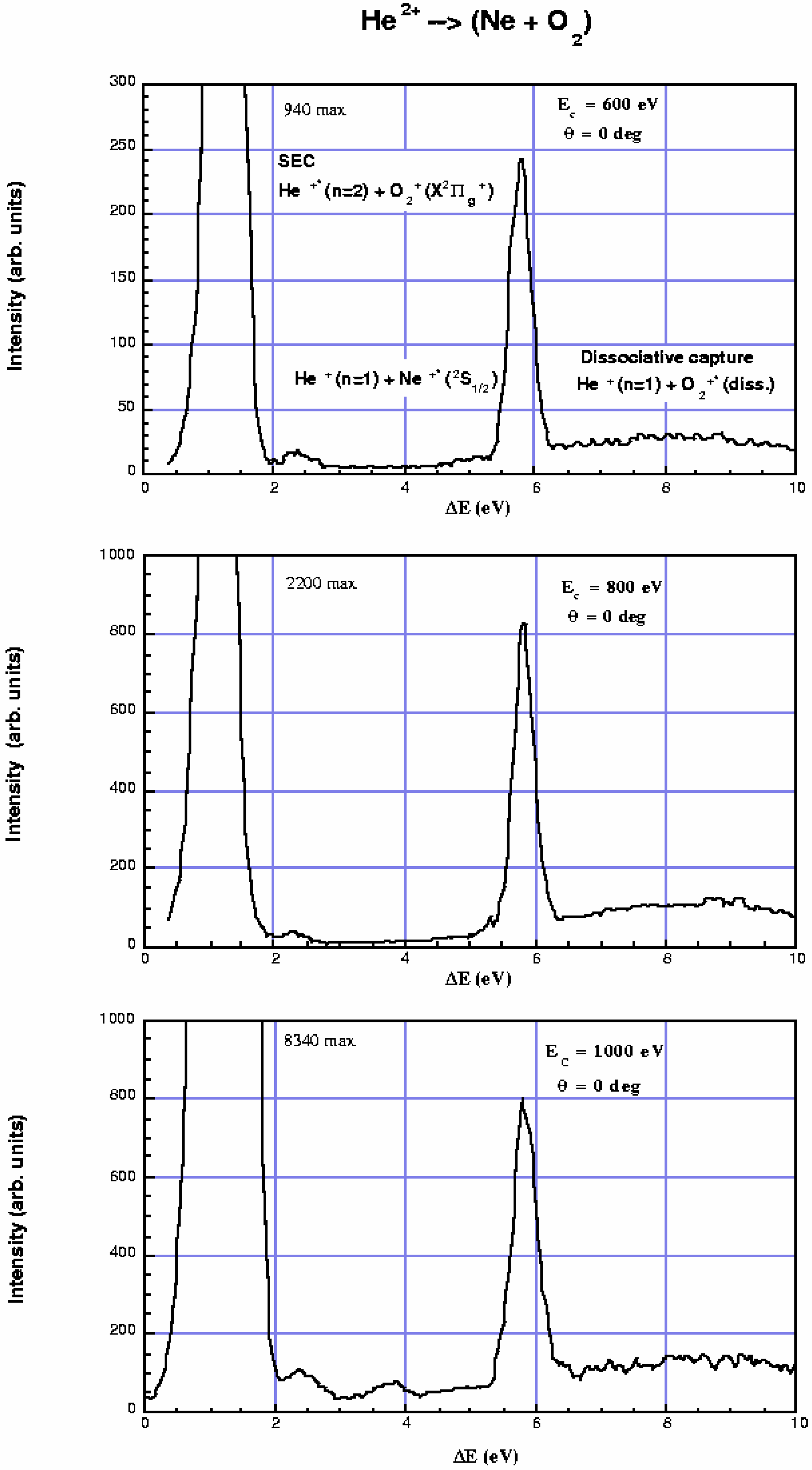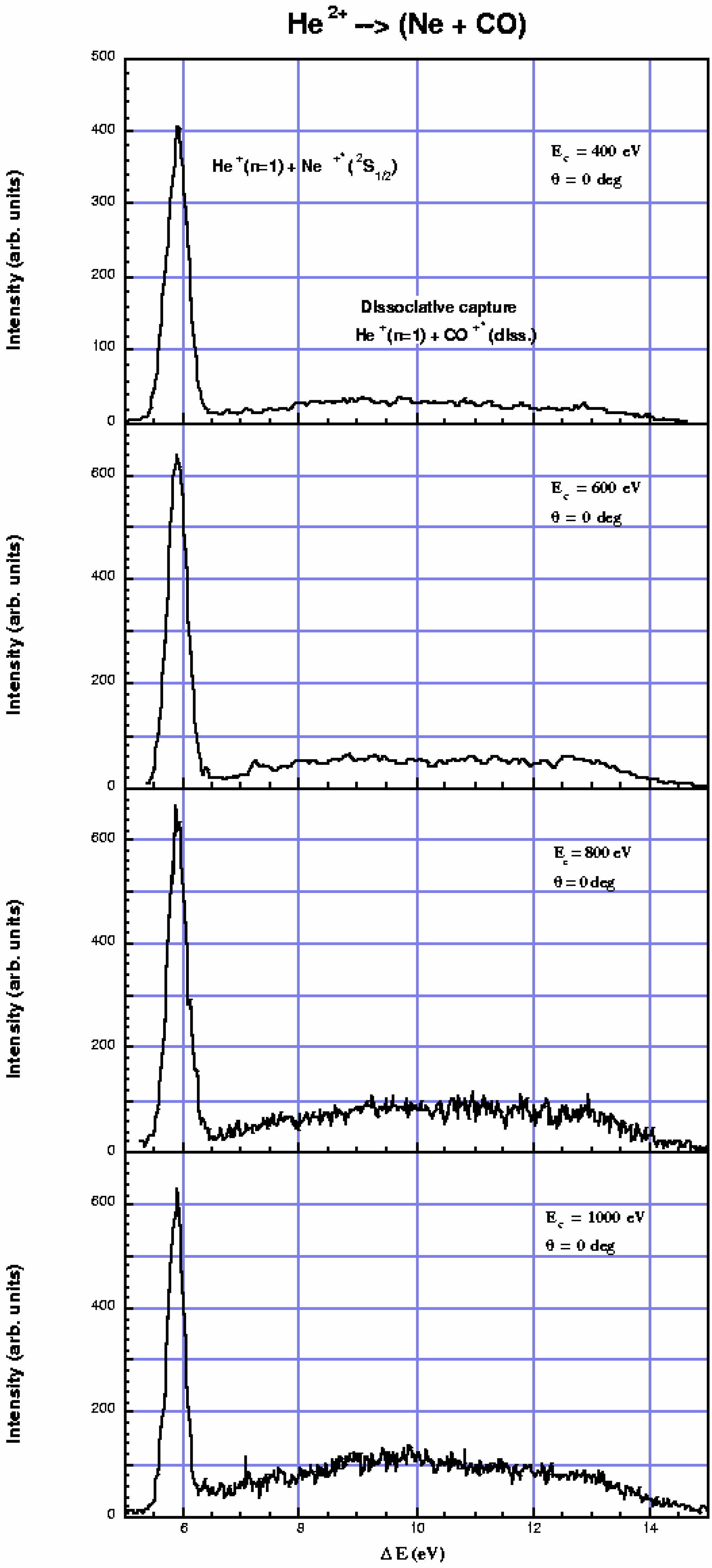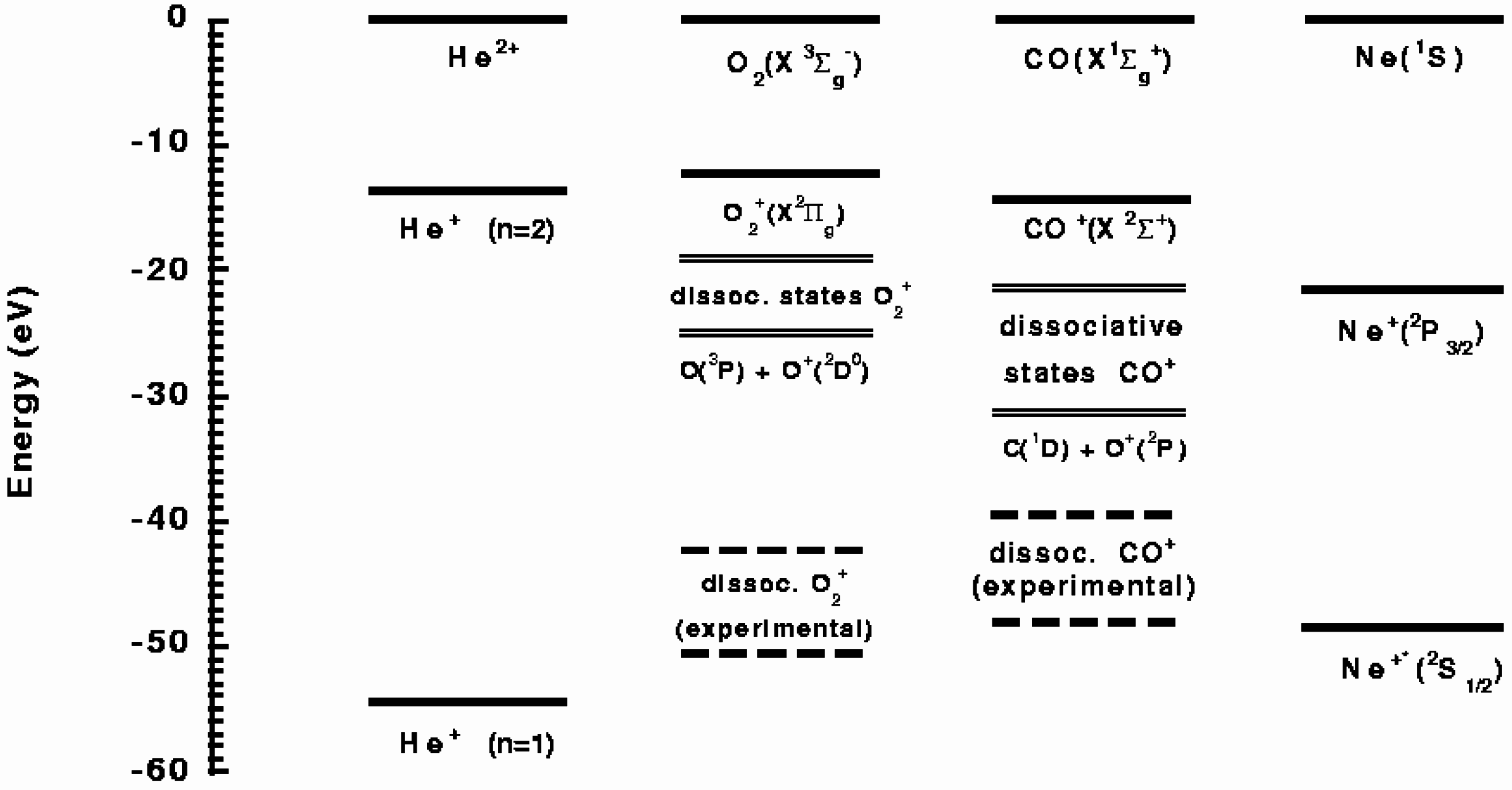1. Influence of metastable states in the primary ion beam
Undefined metastable primary ion beam fractions are a notorious source of experimental uncertainty in low-energy ion collisions, and various techniques may be used as remedy (see [
9] and refs. therein). "Double-translational spectroscopy" involves a first translational spectrometer for preparing primary ions via SEC into well defined states, which then are used in a second translational spectrometer for the SEC studies of actual interest [
10]. Here we have utilized the technically less complex "translational attenuation method" [
11] for dealing with metastable primary ion beam fractions. To this purpose the attenuation cell (cf. fig. 1) in front of our translational energy spectrometer is filled with an appropriate target gas. When passing the mixed beam of ground state- and metastable ions through this attenuation cell, the two or more ion beam components may undergo SEC with different efficiency, which can be seen from characteristic changes in the subsequently measured TES. For the collision system C
2+ - O
2, a well-resolved translational energy spectrum from [
1] is shown in
fig. 2a.
Four SEC channels have been identified which result from C2+(2s2 1S) ground state ions:
C2+(2s2 1S) + O2(X3Σg-) → C+(2p2 4P) + O2+(a4Πui) ΔE = 2.95 eV
C2+(2s2 1S) + O2(X3Σg-) → C+(2p2 2D) + O2+(X2Σg-) ΔE = 3.02 eV
C2+(2s2 1S) + O2(X3Σg-) → C+(2s22p 2P0) + O2+(B2Σg-) ΔE = 4.04 eV
C2+(2s2 1S) + O2(X3Σg-) → C+(2p 2P0) + O2+(b4Σg-) ΔE = 6.18 eV
Three other SEC channels belong to the metastable C2+(2p 3P0)ion (indicated by italic type):
C2+(2p 3P0) + O2(X3Σg-) → C+(2p2 2D) + O2+(b4Σg-) ΔE = 3.39 eV
C2+(2p 3P0) + O2(X3Σg-) → C+(2p2 2P) + O2+(X2Πg) ΔE = 5.09 eV
C2+(2p 3P0) + O2(X3Σg-) → C+(2p2 2P) + O2+(B2Σg-) ΔE = 5.21 eV
In the above reaction channels, energy gains apply to vibrational ground states of the respective product molecular ions. For ion beam attenuation we have used He in the attenuation cell, keeping in mind that then the reaction energy window favours SEC by metastable C
2+ ions [
9]. The attenuation gas pressure was 0.04 mbar as measured with an absolutely calibrated capacitance manometer. The consequent change of the primary beam fractions because of the strongly different SEC is clearly apparent from a corresponding change of the low-resolution TES shown in
fig. 2b. This supports our earlier interpretation of this somewhat complicated TES [
1]. An absolute determination of the metastable ion beam fraction can be made if different attenuation gas pressures are applied [
11].
Another example concerns the collision system N
2+ - CO.
Fig. 3a shows a TES measured for 800 eV impact energy [
12]. The two principal peaks are ascribed to SEC into N
2+(2s
22p
2P
0) ground state ions:
N2+(2s22p 2P0) + CO(X1Σg+) → N+(2p3 3D0) + CO+(X2Σ+) ΔE = 4.15 eV
N2+(2s22p 2P0) + CO(X1Σg+) → N+(2p2 1S) + CO+(B2Σ+) ΔE = 5.85 eV
Fig. 2.
(a) Translational Energy Spectrum for SEC in collisions of C
2+ with O
2 [
1]. (b) TES for SEC in collisions of C
2+ with O
2 (dotted curve for strong attenuation of metastable C
2+ primary ions).
Fig. 2.
(a) Translational Energy Spectrum for SEC in collisions of C
2+ with O
2 [
1]. (b) TES for SEC in collisions of C
2+ with O
2 (dotted curve for strong attenuation of metastable C
2+ primary ions).
Three minor peaks are assigned to the N2+(2s2p2 4P) metastable state ions (indicated by italic type):
N2+(2s2p2 4P) + CO(X1Σg+) → N+(2p3 3P0) + CO+(B2Σ+) ΔE = 3.46 eV
N2+(2s2p2 4P) + CO(X1Σg+) → N+(2p3 3D0) + CO+(B2Σ+) ΔE = 5.56 eV
N2+(2s2p2 4P) + CO(X1Σg+) → N+(2p3 3P0) + CO+(A2Πi) ΔE = 6.58 eV
Fig. 3.
(a) TES for SEC in collisions of N
2+ with CO [
12]. (b) TES for SEC in collisions of N
2+ with CO (dotted curve for strong attenuation of ground state N
2+ primary ions).
Fig. 3.
(a) TES for SEC in collisions of N
2+ with CO [
12]. (b) TES for SEC in collisions of N
2+ with CO (dotted curve for strong attenuation of ground state N
2+ primary ions).
Fig. 3b shows two low-resolution TES, of which one has been mesured with Ne at a pressure of 0.025 mbar in the attenuation cell. This resulted in preferential attenuation of the N
2+ ground statefraction as expected from the SEC energy gains for N
2+ - Ne collisions, keeping in mind the position of the reaction window.
2. SEC by He2+ from O2 and CO
At low impact energy the reaction window favours moderately exothermic reactions (3 ≤ ΔE ≤ 6 eV) over endothermic or strongly exothermic SEC reactions, but with increasing impact energy such pronounced selectivity gradually disappears [
5,
10]. Since TES for He
2+ can show some broad structureless features, we have utilized the well defined SEC reaction
He2+ + Ne(2s22p6 1S) → He+ (n=1) + Ne+ (2s2p6 2S) ΔE = 5.9 eV
for calibration of the TES kinetic energy gain-/loss scale, by adding Ne to the molecular target gases of interest into the collision cell of our translational energy spectrometer.
If the fraction of Ne in the target gas mixture and the above state-selective SEC cross section are known, this provides a convenient way for measuring the absolute state-selective SEC cross sections for the molecular target of interest, by comparing the corresponding TES features with each other. The state-selective SEC cross section for Ne can be conveniently measured because at low impact energy this reaction channel is the only one favoured by the reaction window and therefore its cross section agrees with the total SEC cross section. The latter one can be measured in the further course of this work for the impact energy range of interest. First results of our present studies for SEC by He2+ are summarized as follows.
He2+ + O2 / Ne
TES have been measured for impact energies of 600, 800 and 1000 eV at 0° scattering angle (see
fig. 4). Apart from the calibration peak due to SEC from Ne, the dominant SEC channel involves an energy gain of 1.3 eV and can be identified as non-dissociative SEC
He2+ + O2 (X3Σg-) → He+* (n=2) + O2+ (X2Πg) ΔE = 1.3 eV.
The rather broad feature for energy gains 6 ≤ ΔE ≤ 10 eV corresponds to dissociative SEC into He+(n=1):
He2+ + O2 (X3Σg-) → He+ (n=1) + O2+* (many dissociative states)
We have also measured TES for impact energies from 600 to 1000 eV at a scattering angle of 0.2°. The same reaction channels as mentioned above were observed, but for the finite scattering angle the non-dissociative SEC became slightly less important.
Fig. 4.
TES for direct and dissociative SEC in He2+ - O2 collisions; the peak near 6 eV results from SEC in He2+ - Ne collisions as utilized for calibration of the energy gain scale.
Fig. 4.
TES for direct and dissociative SEC in He2+ - O2 collisions; the peak near 6 eV results from SEC in He2+ - Ne collisions as utilized for calibration of the energy gain scale.
Fig. 5.
TES for dissociative SEC in He2+ - CO collisions; the peak near 6 eV results from SEC in He2+-Ne collisions as utilized for calibration of the energy gain scale.
Fig. 5.
TES for dissociative SEC in He2+ - CO collisions; the peak near 6 eV results from SEC in He2+-Ne collisions as utilized for calibration of the energy gain scale.
He2+ + CO / Ne
For this collision system TES have been measured at impact energies between 400 and 1000 eV at 0° scattering angle (see
fig. 5). Here the non-dissociative SEC channel
He2+ + CO (X1Σg+) → He+* (n=2) + CO+ (X2Σ+) ΔE = - 0.4 eV
was practically not observable despite its small endothermicity, which is in clear contrast to similar measurements performed at only slightly higher impact energies [
7].
Exothermic dissociative SEC channels
He2+ + CO (X1Σg+) → He+ (n=1) + CO+ (many dissociative states)
involve energy gains 6 ≤ ΔE ≤ 15 eV. TES for scattering angles of 0.2° and 1° show similar importance of dissociative SEC with respect to SEC from Ne as for exact forward-scattering.
Fig. 6.
Energy level diagram for SEC in collisions of He2+ with Ne, O2 and CO.
Fig. 6.
Energy level diagram for SEC in collisions of He2+ with Ne, O2 and CO.
Fig. 6 shows energy levels of interest for both collision systems considered. On the left handside the relevant levels for SEC into He
2+ are given, and on the right hand side levels are shown for SEC from Ne which was applied for calibration of the TES energy gain scale. In between we have indicated some energy levels for the target molecules O
2 and CO and their singly charged ions. For O
2 direct SEC into He
+(n=2) is exothermic whereas for CO it is endothermic. The endothermicity is even larger for direct SEC from H
2 and N
2 which explains why for these two collision systems no measurable TES peaks on the endothermic side could be found in our impact energy range. Furthermore, we have indicated known dissociative states for both molecular ions and the energy gain region where actually dissociative SEC has been observed ("experimental"). It is obvious that also for dissociative SEC, in this case into the He
+ ground state, the slightly exothermic reaction channels are strongly preferred.
